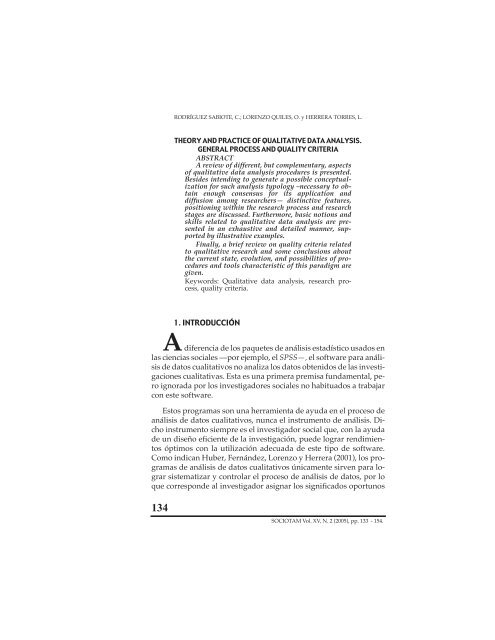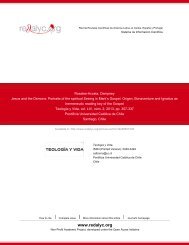Redalyc.Teoría y práctica del análisis de datos cualitativos. Proceso ...
Redalyc.Teoría y práctica del análisis de datos cualitativos. Proceso ...
Redalyc.Teoría y práctica del análisis de datos cualitativos. Proceso ...
Create successful ePaper yourself
Turn your PDF publications into a flip-book with our unique Google optimized e-Paper software.
134<br />
RODRÍGUEZ SABIOTE, C.; LORENZO QUILES, O. y HERRERA TORRES, L.<br />
THEORY AND PRACTICE OF QUALITATIVE DATA ANALYSIS.<br />
GENERAL PROCESS AND QUALITY CRITERIA<br />
ABSTRACT<br />
A review of different, but complementary, aspects<br />
of qualitative data analysis procedures is presented.<br />
Besi<strong>de</strong>s intending to generate a possible conceptualization<br />
for such analysis typology –necessary to obtain<br />
enough consensus for its application and<br />
diffusion among researchers— distinctive features,<br />
positioning within the research process and research<br />
stages are discussed. Furthermore, basic notions and<br />
skills related to qualitative data analysis are presented<br />
in an exhaustive and <strong>de</strong>tailed manner, supported<br />
by illustrative examples.<br />
Finally, a brief review on quality criteria related<br />
to qualitative research and some conclusions about<br />
the current state, evolution, and possibilities of procedures<br />
and tools characteristic of this paradigm are<br />
given.<br />
Keywords: Qualitative data analysis, research process,<br />
quality criteria.<br />
1. INTRODUCCIÓN<br />
A diferencia <strong>de</strong> los paquetes <strong>de</strong> <strong>análisis</strong> estadístico usados en<br />
las ciencias sociales —por ejemplo, el SPSS—, el software para <strong>análisis</strong><br />
<strong>de</strong> <strong>datos</strong> <strong>cualitativos</strong> no analiza los <strong>datos</strong> obtenidos <strong>de</strong> las investigaciones<br />
cualitativas. Esta es una primera premisa fundamental, pero<br />
ignorada por los investigadores sociales no habituados a trabajar<br />
con este software.<br />
Estos programas son una herramienta <strong>de</strong> ayuda en el proceso <strong>de</strong><br />
<strong>análisis</strong> <strong>de</strong> <strong>datos</strong> <strong>cualitativos</strong>, nunca el instrumento <strong>de</strong> <strong>análisis</strong>. Dicho<br />
instrumento siempre es el investigador social que, con la ayuda<br />
<strong>de</strong> un diseño eficiente <strong>de</strong> la investigación, pue<strong>de</strong> lograr rendimientos<br />
óptimos con la utilización a<strong>de</strong>cuada <strong>de</strong> este tipo <strong>de</strong> software.<br />
Como indican Huber, Fernán<strong>de</strong>z, Lorenzo y Herrera (2001), los programas<br />
<strong>de</strong> <strong>análisis</strong> <strong>de</strong> <strong>datos</strong> <strong>cualitativos</strong> únicamente sirven para lograr<br />
sistematizar y controlar el proceso <strong>de</strong> <strong>análisis</strong> <strong>de</strong> <strong>datos</strong>, por lo<br />
que correspon<strong>de</strong> al investigador asignar los significados oportunos<br />
SOCIOTAM Vol. XV, N. 2 (2005), pp. 133 - 154.

















